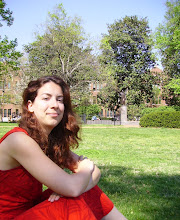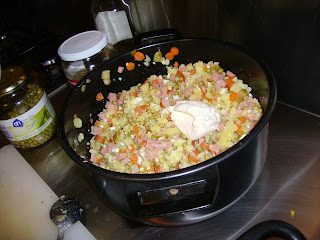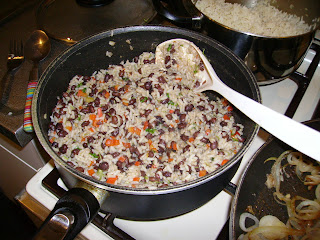 How I get in touch with my various generous hosts is quite diverse. Often it happens through mutual friends, and I stumbled across the host for my Albanian meal (no. 46) while he was picknicking in the park. Kristina, however, contacted me just minutes after I got a Skype account. I saw her last name and immediately asked where she was from....and what do you know, Bulgaria, unchartered territory for this blog! She seemed to take my strange request for a meal in her stride (after she checked out the website) and a few days later I am ringing her doorbell just minutes away from my own home. I get to know her husband (a mathematician with Russian roots) and her baby boy, Marin, with luminous blue eyes.
How I get in touch with my various generous hosts is quite diverse. Often it happens through mutual friends, and I stumbled across the host for my Albanian meal (no. 46) while he was picknicking in the park. Kristina, however, contacted me just minutes after I got a Skype account. I saw her last name and immediately asked where she was from....and what do you know, Bulgaria, unchartered territory for this blog! She seemed to take my strange request for a meal in her stride (after she checked out the website) and a few days later I am ringing her doorbell just minutes away from my own home. I get to know her husband (a mathematician with Russian roots) and her baby boy, Marin, with luminous blue eyes.Kristina came to Holland to study piano and now practices daily in her colourful flat.
 Her son is growing up surrounded by music...and good food!
Her son is growing up surrounded by music...and good food!Our starter is a deliciously tart yoghurt and cucumber soup called tarator. Kristina assures me is very simple to make and it seems perfect for summer dinners; you can just take it from the fridge and it's ready to serve cold.
The main course is warm and hearty, a 'meat and potato' dish, musaka. It is somewhat similar to the more famous Greek moussaka, but without eggplant (aubergine). Kristina is a bit embarrassed, because he
 r musaka turned out darker than she would have liked (some would even say burnt), but it is quite tasty nevertheless! It is accompanied by fresh salads and a lovely flower-shaped bread called pitka.
r musaka turned out darker than she would have liked (some would even say burnt), but it is quite tasty nevertheless! It is accompanied by fresh salads and a lovely flower-shaped bread called pitka.After dinner we discuss similarities between Russia and Bulgaria as former USSR nations, I play with Marin (carefully, as I don't want him to catch my cold)
 and listen to an impromptu piano recital from Kristina. Sadly, I have to admit I cannot remember the evening in much detail as I have delayed posting this story almost a year after moving to the UK. Every time I log in to Skype I feel enormously guilty seeing that Kristina is online and without anything to show for all her efforts. The last time we chatted through Skype, she even sent me new photos of her son, who has of course grown enormously since I saw him. But the luminous blue eyes and gentle smile are the same. I wonder if he will feel Russian-Bulgarian when he grows up, or Dutch-Bulgarian-Russian? But who knows where their little family will settle permanently? A pianist and a mathematician can grow roots in many countries...
and listen to an impromptu piano recital from Kristina. Sadly, I have to admit I cannot remember the evening in much detail as I have delayed posting this story almost a year after moving to the UK. Every time I log in to Skype I feel enormously guilty seeing that Kristina is online and without anything to show for all her efforts. The last time we chatted through Skype, she even sent me new photos of her son, who has of course grown enormously since I saw him. But the luminous blue eyes and gentle smile are the same. I wonder if he will feel Russian-Bulgarian when he grows up, or Dutch-Bulgarian-Russian? But who knows where their little family will settle permanently? A pianist and a mathematician can grow roots in many countries...






















